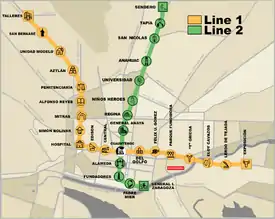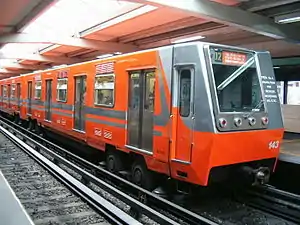Metrorrey
Metrorrey, officially Sistema de Transporte Colectivo Metrorrey, is a light metro system in Monterrey, Nuevo León, Mexico. While it calls itself a "Metro", it is actually a medium-capacity rail system. Operations began in 1991.[3] As of 2014, the system operates 40 high-floor electric trains,[2] along a total system of 31 stations with a length of 32 kilometers (20 mi).[2]
 | |||||||||||||||||||||||||||||||||||||||||||||||||||||||||||||||||||||||||||||||||||||||||||||||||||||||||||||||||||||||||||||||||||||||||||||||||||||||||||||||||||||||
 Train arriving at Talleres Station. | |||||||||||||||||||||||||||||||||||||||||||||||||||||||||||||||||||||||||||||||||||||||||||||||||||||||||||||||||||||||||||||||||||||||||||||||||||||||||||||||||||||||
| Overview | |||||||||||||||||||||||||||||||||||||||||||||||||||||||||||||||||||||||||||||||||||||||||||||||||||||||||||||||||||||||||||||||||||||||||||||||||||||||||||||||||||||||
|---|---|---|---|---|---|---|---|---|---|---|---|---|---|---|---|---|---|---|---|---|---|---|---|---|---|---|---|---|---|---|---|---|---|---|---|---|---|---|---|---|---|---|---|---|---|---|---|---|---|---|---|---|---|---|---|---|---|---|---|---|---|---|---|---|---|---|---|---|---|---|---|---|---|---|---|---|---|---|---|---|---|---|---|---|---|---|---|---|---|---|---|---|---|---|---|---|---|---|---|---|---|---|---|---|---|---|---|---|---|---|---|---|---|---|---|---|---|---|---|---|---|---|---|---|---|---|---|---|---|---|---|---|---|---|---|---|---|---|---|---|---|---|---|---|---|---|---|---|---|---|---|---|---|---|---|---|---|---|---|---|---|---|---|---|---|---|---|
| Native name | Sistema de Transporte Colectivo Metrorrey | ||||||||||||||||||||||||||||||||||||||||||||||||||||||||||||||||||||||||||||||||||||||||||||||||||||||||||||||||||||||||||||||||||||||||||||||||||||||||||||||||||||||
| Owner | Nuevo León state government | ||||||||||||||||||||||||||||||||||||||||||||||||||||||||||||||||||||||||||||||||||||||||||||||||||||||||||||||||||||||||||||||||||||||||||||||||||||||||||||||||||||||
| Locale | Monterrey, Nuevo León, México | ||||||||||||||||||||||||||||||||||||||||||||||||||||||||||||||||||||||||||||||||||||||||||||||||||||||||||||||||||||||||||||||||||||||||||||||||||||||||||||||||||||||
| Transit type | Light Metro | ||||||||||||||||||||||||||||||||||||||||||||||||||||||||||||||||||||||||||||||||||||||||||||||||||||||||||||||||||||||||||||||||||||||||||||||||||||||||||||||||||||||
| Number of lines | 2[1] | ||||||||||||||||||||||||||||||||||||||||||||||||||||||||||||||||||||||||||||||||||||||||||||||||||||||||||||||||||||||||||||||||||||||||||||||||||||||||||||||||||||||
| Number of stations | 31[1] | ||||||||||||||||||||||||||||||||||||||||||||||||||||||||||||||||||||||||||||||||||||||||||||||||||||||||||||||||||||||||||||||||||||||||||||||||||||||||||||||||||||||
| Daily ridership | 495,000 (2018)[2] | ||||||||||||||||||||||||||||||||||||||||||||||||||||||||||||||||||||||||||||||||||||||||||||||||||||||||||||||||||||||||||||||||||||||||||||||||||||||||||||||||||||||
| Annual ridership | 180.8 million (2018)[2] | ||||||||||||||||||||||||||||||||||||||||||||||||||||||||||||||||||||||||||||||||||||||||||||||||||||||||||||||||||||||||||||||||||||||||||||||||||||||||||||||||||||||
| Website | STC Metrorrey | ||||||||||||||||||||||||||||||||||||||||||||||||||||||||||||||||||||||||||||||||||||||||||||||||||||||||||||||||||||||||||||||||||||||||||||||||||||||||||||||||||||||
| Operation | |||||||||||||||||||||||||||||||||||||||||||||||||||||||||||||||||||||||||||||||||||||||||||||||||||||||||||||||||||||||||||||||||||||||||||||||||||||||||||||||||||||||
| Began operation | 1991 (Line 1)[3] 1994 (Line 2)[3] | ||||||||||||||||||||||||||||||||||||||||||||||||||||||||||||||||||||||||||||||||||||||||||||||||||||||||||||||||||||||||||||||||||||||||||||||||||||||||||||||||||||||
| Operator(s) | Sistema de Transporte Colectivo Metrorrey | ||||||||||||||||||||||||||||||||||||||||||||||||||||||||||||||||||||||||||||||||||||||||||||||||||||||||||||||||||||||||||||||||||||||||||||||||||||||||||||||||||||||
| Character | Elevated & underground | ||||||||||||||||||||||||||||||||||||||||||||||||||||||||||||||||||||||||||||||||||||||||||||||||||||||||||||||||||||||||||||||||||||||||||||||||||||||||||||||||||||||
| Number of vehicles | 84 | ||||||||||||||||||||||||||||||||||||||||||||||||||||||||||||||||||||||||||||||||||||||||||||||||||||||||||||||||||||||||||||||||||||||||||||||||||||||||||||||||||||||
| Train length | 2–3 cars | ||||||||||||||||||||||||||||||||||||||||||||||||||||||||||||||||||||||||||||||||||||||||||||||||||||||||||||||||||||||||||||||||||||||||||||||||||||||||||||||||||||||
| Technical | |||||||||||||||||||||||||||||||||||||||||||||||||||||||||||||||||||||||||||||||||||||||||||||||||||||||||||||||||||||||||||||||||||||||||||||||||||||||||||||||||||||||
| System length | 32 km (20 mi)[2] | ||||||||||||||||||||||||||||||||||||||||||||||||||||||||||||||||||||||||||||||||||||||||||||||||||||||||||||||||||||||||||||||||||||||||||||||||||||||||||||||||||||||
| |||||||||||||||||||||||||||||||||||||||||||||||||||||||||||||||||||||||||||||||||||||||||||||||||||||||||||||||||||||||||||||||||||||||||||||||||||||||||||||||||||||||
Operations
Lines
The Metrorrey has two lines with 31 stations.[1]
Line 1 opened on April 25 of 1991[3] and has 19 stations, it runs through the center of the city from the north-west to the eastern part of the Monterrey metropolitan area. Built as an 18.5 km (11.5 mi) long line,[4] it runs parallel to the former 1887 Topo Chico tramline and is grade-separated as it runs on an elevated structure. A complete ride along this line takes about 27 minutes.[3]
Line 2 has 13 stations and is 13 km (8.1 mi) long, it is also fully grade-separated, partially on an elevated structure and partially underground, running from the center of the city towards the north. The first 4.5 km (2.8 mi) long underground segment opened on November 30 of 1994 with 6 stations,[3] with the possibility of transferring to Line 1 at Cuauhtémoc station. In 2005 construction began on an expansion to the line with a total investment of US$200 million. Said expansion comprised 2 phases, the first one being 3.2 km (2.0 mi)(1.5 km (0.93 mi) of it underground) long, it opened on October 31 of 2007 adding 3 more stations to the line.[3] The second phase added another 5.3 km (3.3 mi) of elevated railway along the center of the Universidad avenue and 4 more stations, it was inaugurated on October 9 of 2008[3] by Nuevo León Governor Natividad González Parás and Mexican president Felipe Calderón.
Construction is in progress for a third rail line (Linea 3). Early in 2018, the state of Nuevo Leon signed a funding agreement to provide 600 million pesos to Metrorrey for continued construction on Linea 3. Up to that period, Metrorrey reported total expenditures on Linea 3 of over 10 billion pesos. The transit agency claims it will be spending these funds for viaducts, and station features, such as awnings, elevators, and escalators.[5] As of January 2020, construction for Linea 3 is complete, according to the Secretaría de Comunicaciones y Transportes (SCT), the federal transportation agency. However, state government officials state that service is not available because the rolling stock has not been delivered. At that time, estimated delivery for twenty-six rail cars was December 2020. Linea 3 covers runs a total distance of 7.5 kilometers, part of which is underground and part is elevated. The line is supported by eight rail stations.[6] Some of the 26 railcars have arrived and have passed on track testing as of August 2020, though not all of the railcars had arrived at that time. A Metrorrey spokesperson says that a new opening date for Linea 3 is February 2021, though he also noted that the Corona virus has played no role in the most recent timetable.[7]
Ridership
According to Mexico's National Institute of Statistics, Geography and Informatics, Metrorrey's two lines transported 180.8 million passengers in 2018, which corresponds to an average daily ridership of 495,000 passengers.[2]
Fares
The following are the travel fares as of 2018:
- Single Trip - MXN4.50 (~USD0.22)
- 2 Trips - MXN8.00 (~USD0.39)
- Metrobus - From bus to Metro: Cash: MXN12.00 (~USD0.64), with "Feria" card: MXN11.79 (~USD0.62), From Metro to bus: MXN8.00 (~ USD0.42)
Metrorrey also offered "Boletos Multiviaje" (multitrip tickets) until 2016. These tickets were intended for recurrent users and they are sold in denominations ranging from 15 to 85 trips.
Since the opening of the extension of the Line 2, Metrorrey began offering the "Mia" Card, a rechargeable card that can be loaded with multiple trip credits. The "Mia" card can be initially purchased for MXN20 (~USD0.97) and can be recharged in increments ranging from MXN1 to MXN100. (~USD0.05 to ~USD4.83) Also, every MXN4, are added MXN0.50.
On May 16, 2009, Nuevo León governor Natividad González Parás announced that Metrorrey would be free for the following 60 days, as part of a program to reduce the effects of the economic downturn on citizens.[8]
Rolling stock
The Metrorrey system uses 84 high-floor articulated vehicles, used to form two- or three-car trainsets each, with the possibility of forming up to four-car trainsets. The MM-93 cars have an air-conditioning system. The first 23 cars were manufactured in 1990 by the Mexican government-owned Concarril (the National Railway Car Manufacturing Company) and the next 25 in 1992–93 by the Canadian company Bombardier, after it acquired Concarril in 1992, all 48 of these cars being built at a factory in Ciudad Sahagún, Mexico, and the two batches being "nearly identical".[4] Those 48 cars were followed by 22 that were built in Spain by CAF, with the remaining 14 vehicles built by Bombardier. Specifically, Metrorrey ordered 25 two-section MM-90 cabs in 1988, and 23 MM-90/2F cabs in 1990 from Bombardier for Line 1; the latter type represents the second generation of the same vehicle equipped with high-tech components, including, among other things, asynchronous traction motors with the power supplied by catenary. The MM-93 cab, debuted during the opening of the Line 2, including full-closed windows, and an air-conditioning system, and following the expansion of Line 2, Metrorrey acquired 16 cabs based in an evolution of MM-90 / MM-90/2F cab.
In 2019, Metrorrey bought 24 former Frankfurt U-Bahn Type U3 trains, which were withdrawn from U-Bahn service in 2017.[9] The trains were built by DUEWAG in 1979 and 1980, and will undergo a refurbishment programme by Talbot Services to extend their service life by 20 years.[9]
Transmetro
Metrorrey also has a bus system that uses exclusive and obligatory stops along its route. It has nine lines. On Metrorrey Line 1 there are four Transmetro lines, three in Talleres station and one in Exposición station. On Line 2 there are five more Transmetro lines, two at San Nicolas (Santo Domingo and Las Puentes) and three more at Sendero (Montreal, Fomerrey, and Apodaca). There is no additional fee, other than the standard Metro Ticket, to use Transmetro.
Future service
In July 2014, a contract was signed with CAF for 26 trains to run on Line 3.[10] According to a spokesperson for Metrorrey, Line 3 is schedule to begin service in February 2021.[11]
Gallery
 Interior of an MM-93 train
Interior of an MM-93 train Looking down into the ticketing area of Zaragoza Station
Looking down into the ticketing area of Zaragoza Station Ticket vendor
Ticket vendor Metrobus stops at Exposicion Station
Metrobus stops at Exposicion Station Transfer point at Cuauhtemoc Station
Transfer point at Cuauhtemoc Station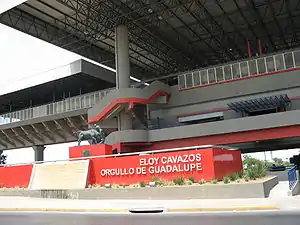 Eloy Cavazos Station
Eloy Cavazos Station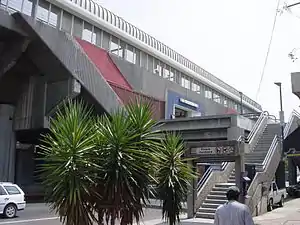 Parque Fundidora Station
Parque Fundidora Station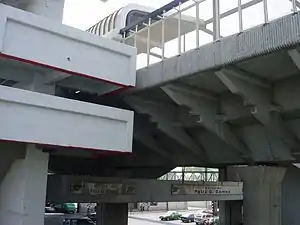 Felix U. Gomez Station
Felix U. Gomez Station General Anaya Station
General Anaya Station Accessibility sign
Accessibility sign Transmetro in Talleres Station
Transmetro in Talleres Station
Network Map

See also
References
- "Red Metro" [Metro Network (map)] (in Spanish). Sistema de Transporte Colectivo Metrorrey. Archived from the original (jpg) on 2013-07-03. Retrieved 2013-08-06.
- "Comunicaciones y transportes - Principales características del sistema de transporte colectivo metrorrey". Banco de Información Económica - Instituto Nacional de Estadísitica y Geografía (INEGI). Retrieved 2018-08-15.
- "Sistema de Transporte Colectivo Metrorrey - Historia" [System of Collective Transport Metrorrey - History] (in Spanish). Gobierno del Estado de Nuevo León. Archived from the original on 2013-10-24. Retrieved 2013-08-06.
- May, Jack (1994). "Mexico Says Sí to LRT: Light Rail South of the Border". 1994 Light Rail Annual & User's Guide, p. 7. Pasadena, CA (US): Pentrex. ISSN 0160-6913.
- Juarez, Pilar (March 29, 2018). "Reasignan 600 mdp para obras de Línea 3 del Metrorrey". Milenio. Retrieved June 2, 2018.
- "Línea 3 del Metro está lista, pero sin vagones". Milenio (in Spanish). 11 July 2019. Retrieved 2020-01-17.
- CAROLINA LEÓN Y KEVIN RECIO (29 August 2020). "Metrorrey: covid-19 no retrasará la Línea 3". Milenio2020 (in Spanish). Retrieved 29 August 2020.
- Zúñiga Esquivel, Francisco (16 May 2009). "Nati dará agua y Metro gratis por dos meses" [Nati will give free Metro and water for two months]. Milenio (in Spanish). Archived from the original on 20 June 2009. Retrieved 3 September 2009.
- "Monterrey/ Mexiko, kauft 24 durch Talbot Services modernisierte U3-Stadtbahnwagen der VGF Frankfurt/ Main" [Monterrey/ Mexico, buys 24 modernized U3 trains from VGF Frankfurt/ Main]. Urban Transport Magazine (in German). October 17, 2019. Archived from the original on October 18, 2019. Retrieved October 18, 2019.
- "Spain's CAF Wins Train Contract in Mexico". Latin American Herald Tribune. Retrieved June 3, 2018.
- CAROLINA LEÓN Y KEVIN RECIO (29 August 2020). "Metrorrey: covid-19 no retrasará la Línea 3". Milenio2020 (in Spanish). Retrieved 29 August 2020.
External links
![]() Media related to Monterrey Metro at Wikimedia Commons
Media related to Monterrey Metro at Wikimedia Commons
- Metrorrey – official website
- Monterrey (Metrorrey) at UrbanRail.net
- Siemens Receives Order to Extend the Metro in Monterrey, Mexico
- The Tramways of Monterrey
